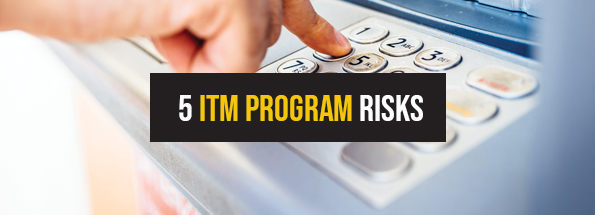5 ITM Program Risks CIT Carriers Must Address

Interactive Teller Machines (ITMs) represent a major shift in CIT carriers’ operations and that entails an added set of risks. In a global sense, ITMs offer an opportunity to expand a portfolio of cash management services that can make a CIT carrier even more important to a banking system. The rise of ITMs expose carriers to banks’ evolving policies on the use of ITMs within their own operations. This is a risk to which carriers can only adapt as banks’ operations become clear.
Beyond this, there is a set of specific risks that accompany ITMs. These risks are inherent in the flow of cash through the CIT system and changes in policies and procedures will be required to manage them so that the expanded cash management services are profitable. Here are 5 key ITM servicing risks that must be included in the CIT carrier’s risk management planning:
1. Loss of Life
By their actions, some people put a monetary value on life. This is incomprehensible to most of us, but it is a fact. The large amount of cash in a carriers’ truck or vault has always been a magnet to a few who will risk everything for a big payday. The advent of the ITM does not change this, though it may make the exposure even larger.
The reason we look at the extreme risk, loss of life, is because it focuses our attention on the fact that carrier’s risk evaluation and mitigation demand a comparably extreme approach given the potential catastrophic loss.
2. Increasing Violence
There is evidence that the extreme risks carriers face are increasing. Robberies are initiated with a drawn weapon more and more often. Robbers know that their “adversaries” are also armed, so the very fact that they persist in the attack indicates they are willing to use deadly force.
All carriers train extensively for these potentially violent encounters. The ITM poses challenges that make this even more important.
3. Servicing Complexity
ITMs offer customers greater flexibility in cash services and a wider range of transactions, up to and including opening new accounts of certain types. All of this makes the spot audits, transaction history, cash servicing, and record keeping more complicated. This all takes more time to service than the traditional ATM.
Greater time in service means the carrier crew is exposed to attack for a longer time. When more than one ITM is serviced in sequence at a single location, this effect is magnified. Carriers’ risk mitigation policies need equally robust improvements to accommodate the more vulnerable circumstances.
4. Organizational Fraud
The interactive feature of ITMs is one of its most attractive benefits. However, it sometimes means that a remote employee has to attend to a customer for a certain kind of transaction, such as identity verification or to explain and authorize a transaction. That means there’s a person on the “inside” who has access to some aspects of the cash management system, with a corresponding potential for fraud.
While this is in some sense the bank’s problem, carriers will often be held accountable for the failures that do occur. On the positive side, carriers can use this as an opportunity to deepen their cooperation with their banking partners.
Of course, another source of fraud is the CIT carriers’ own employees. ITMs require new internal controls and audits to address the new risks they pose.
5. Labor Shortages
Every CIT carrier already knows there are precious few employees and potential employees who can handle the high intensity risk of cash management with intelligence and calm. The currently tight labor market doesn’t help, and ITM complexity and service demand could make the situation even worse.
This risk has to do with the character and capability of employees and applicants. A very thorough background check can help, followed with intensive and on-going training. Given the high value of a tested and trusted employee, the premium on retention should be a special focus.
CIT carriers have always operated in a risky environment, so in one sense the addition of the ITM is business as usual. But the ITM is something new on the carriers’ routes, with a tighter integration to banks’ internal processes and a new class of risks built on the decentralized capabilities of the machines.
For a more thorough overview of how ITMs are changing CIT carriers’ operations, download A CIT Carrier’s Guide to Building Your ITM Program.